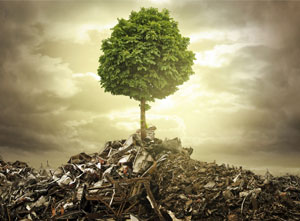The Future of Resource Recovery Generates Career Opportunities
The Future of Resource Recovery Generates Career Opportunities

By Srinivasa Jeyakumar, PE, Mechanical Engineering Special with Suncor Energy
With seven billion individuals in this world, we produce a lot of trash. In the U.S. alone, we produce 4.6 pounds of trash each day/person. This amounted to 150 million tons of municipal solid waste being discarded in landfills in 2012. This is because only 35% of what we use gets recycled.
It might sound counter intuitive but recycling can be cheaper than manufacturing. For example, recycling gold from old computer motherboards is far more efficient and less environmentally destructive than extracting it from the earth, often by surface-mining that risks unspoiled rain forests! However, the United Nations Environmental Program estimates that only about 10% of the millions of tons of electronic waste generated around the world is properly recycled.
Recycling can help extract the maximum benefit from natural resources, delay consumption of virgin natural resources, and produce minimum amount of waste by disposing in a suitable, environmentally friendly manner. However, recycling is just one of the means to the end, termed broadly as resource recovery. Resource recovery is the process of building, reprocessing or developing new products such as recycling, composting or energy generation from disposed product/materials. Current resource recovery technologies include reusing wastes directly in the original production processes, turning waste into other valuable products according to their characteristics or even better, upscale them, where your recycled product has more value than the original product. Clothing is one industry which has historically used upscaling, where old out-of-style clothes worth $1-10 are tailored together in bits and pieces into fashionable items that are priced at $100+.
Currently, in many countries, it's not part of the regular routine to gather our tin cans and plastic bottles, walk to the local recycling center (if one is available), and dump it there. However, new resource recovery technologies plan to change that. Some countries like Scotland, Japan and the US are introducing Reverse Vending Machines. As its name suggests, instead of dispensing canned and bottled drinks, these machines actually take in empty cans and bottles, and dispense out dockets that can in turn be exchanged for cash.
If you can recycle cans, why not cars? In Japan, when a car is all hollowed out, the remaining body is pressed into dice-sized chips and processed into metal scrap. At the end of the process, more than 90% of the car's material is recycled, the highest in the country, and as more research and development goes into this field, we could even see 95% of cars there being recycled.
Organic waste is another class of material suitable for reuse and repurposing. A new approach of dissolving, filtering and precipitating PVC was used after the London Olympics 2012 to prevent toxic air pollutants to fulfill the PVC disposal policy. More futuristically, organic waste can be recovered using bacteria which could enable newspaper-powered cars in the future. Researchers at Tulane University in New Orleans discovered a strain of bacteria that can turn paper into butanol, a biofuel that can be used in some cars in place of regular petrol. The bacteria called TU-103, which is believed to be the first natural bacterial strain to make butanol directly from cellulose – the material available in all green plants, and old newspapers. In the United States alone, at least 323 million tons of cellulosic materials that could be used to produce butanol are thrown out each year.
Similarly, scientists at the University College Dublin found a bacterium that eats polystyrene foam and turns it into a useable plastic. Then, it is fed to the bacteria who convert it into PHA, a biodegradable plastic. It can be used to create packaging film and plastic forks. Unlike polystyrene foam, it is able to biodegrade in water and soil.
This has created a slew of opportunities for today's engineers interested in participating in this type of research work or adapting this work in the industry. The research showcased above is just the tip of the iceberg and needs further research in the fields of bioengineering to develop these technologies. Engineers with backgrounds in basic engineering such as mechanical, chemical, or environmental sciences can pursue research in this area. This also calls for domain experts in each type of material being dealt with; for example, when you are recycling cans into reusable metal scrap, one would be expected to have skills in metallurgy or materials engineering.
Basic research needs engineers to adapt the technology to make it cost-competitive and industrial scale. Project and process engineers are definitely a must to convert lab-scale processes into industrial processes. Some background in environmental sciences is helpful. Early career engineers can get on the job training in process development that gets them exposed to the company's production details. Young engineers with design, process, or project management experience and knowledge can make a career in resource recovery. A Bachelor's degree can be sufficient for the process development, plant engineering and operations tasks. However, it would be advisable to pursue a Master's degree to get involved in basic research. Either in industry or basic research, a career in resource recovery is a way to help make this world a better place through your work.
---------------------------------------------------------------------------
This article has been adapted from a previously published article titled, “The Future of Resource Recovery” in the Process Industries Division Newsletter (2014 Winter Edition).


